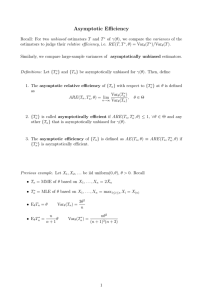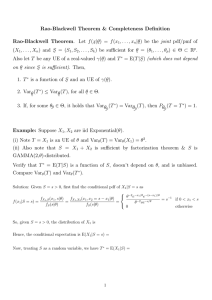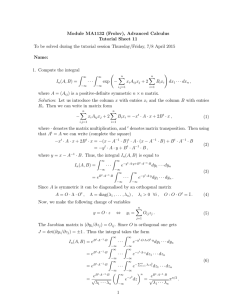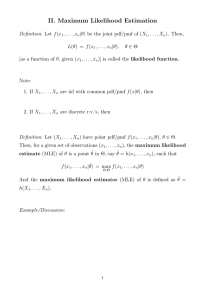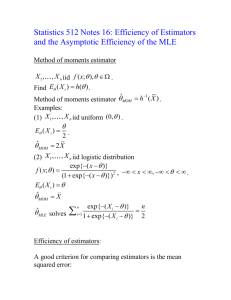Cram` er-Rao Inequality
advertisement
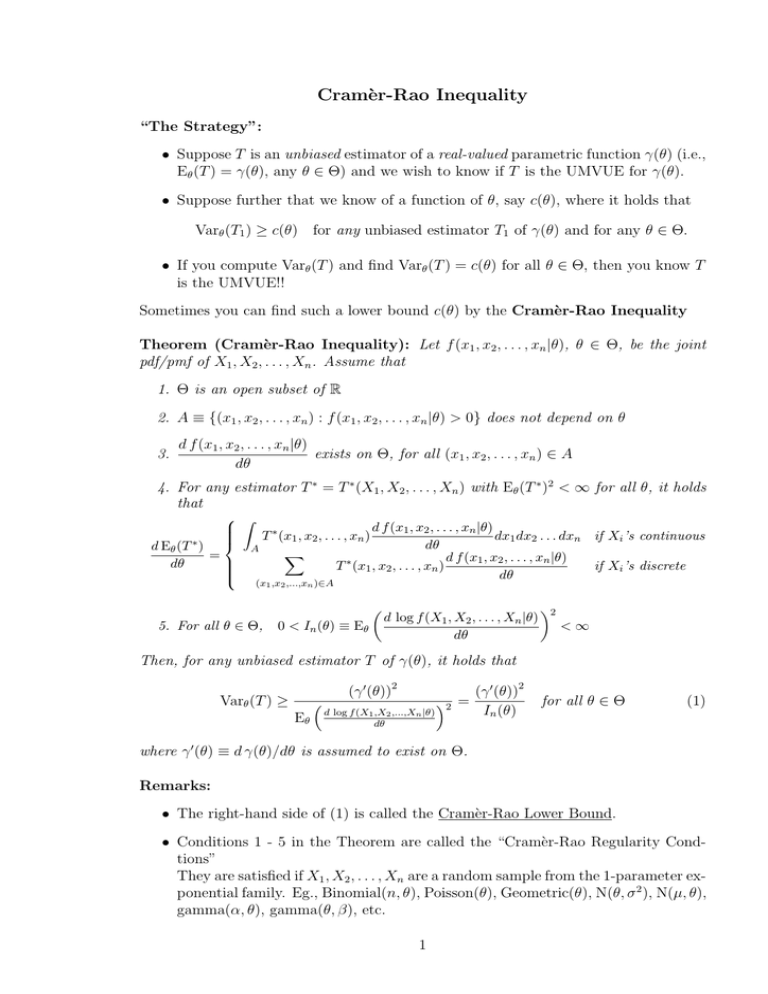
Cramèr-Rao Inequality
“The Strategy”:
• Suppose T is an unbiased estimator of a real-valued parametric function γ(θ) (i.e.,
Eθ (T ) = γ(θ), any θ ∈ Θ) and we wish to know if T is the UMVUE for γ(θ).
• Suppose further that we know of a function of θ, say c(θ), where it holds that
Varθ (T1 ) ≥ c(θ) for any unbiased estimator T1 of γ(θ) and for any θ ∈ Θ.
• If you compute Varθ (T ) and find Varθ (T ) = c(θ) for all θ ∈ Θ, then you know T
is the UMVUE!!
Sometimes you can find such a lower bound c(θ) by the Cramèr-Rao Inequality
Theorem (Cramèr-Rao Inequality): Let f (x1 , x2 , . . . , xn |θ), θ ∈ Θ, be the joint
pdf/pmf of X1 , X2 , . . . , Xn . Assume that
1. Θ is an open subset of R
2. A ≡ {(x1 , x2 , . . . , xn ) : f (x1 , x2 , . . . , xn |θ) > 0} does not depend on θ
3.
d f (x1 , x2 , . . . , xn |θ)
exists on Θ, for all (x1 , x2 , . . . , xn ) ∈ A
dθ
4. For any estimator T ∗ = T ∗ (X1 , X2 , . . . , Xn ) with Eθ (T ∗ )2 < ∞ for all θ, it holds
that
Z
d f (x1 , x2 , . . . , xn |θ)
T ∗ (x1 , x2 , . . . , xn )
dx1 dx2 . . . dxn if Xi ’s continuous
∗
dθ
d Eθ (T )
A
X
=
d f (x1 , x2 , . . . , xn |θ)
dθ
T ∗ (x1 , x2 , . . . , xn )
if Xi ’s discrete
dθ
(x1 ,x2 ,...,xn )∈A
µ
5. For all θ ∈ Θ,
0 < In (θ) ≡ Eθ
d log f (X1 , X2 , . . . , Xn |θ)
dθ
¶2
<∞
Then, for any unbiased estimator T of γ(θ), it holds that
(γ 0 (θ))2
´2 =
³
In (θ)
d log f (X1 ,X2 ,...,Xn |θ)
(γ 0 (θ))2
Varθ (T ) ≥
Eθ
for all θ ∈ Θ
(1)
dθ
where γ 0 (θ) ≡ d γ(θ)/dθ is assumed to exist on Θ.
Remarks:
• The right-hand side of (1) is called the Cramèr-Rao Lower Bound.
• Conditions 1 - 5 in the Theorem are called the “Cramèr-Rao Regularity Condtions”
They are satisfied if X1 , X2 , . . . , Xn are a random sample from the 1-parameter exponential family. Eg., Binomial(n, θ), Poisson(θ), Geometric(θ), N(θ, σ 2 ), N(µ, θ),
gamma(α, θ), gamma(θ, β), etc.
1
• In (θ) is called the Fisher Information number (for size n sample)
• If X1 , X2 , . . . , Xn are iid with common pdf/pmf f (x|θ), then
µ
¶2
d log f (X1 |θ)
In (θ) = nI1 (θ), where I1 (θ) = Eθ
dθ
(2)
and I1 (θ) represents the Fisher information for one observation.
d2 f (x1 , x2 , . . . , xn |θ)
exits on Θ, for all (x1 , x2 , . . . , xn ) ∈ A, then
dθ2
¶2
µ 2
µ
¶
d log f (X1 , X2 , . . . , Xn |θ)
d log f (X1 , X2 , . . . , Xn |θ)
= −Eθ
In (θ) = Eθ
.
dθ
dθ2
• If
If, in addition, X1 , X2 , . . . , Xn are iid with common pdf/pmf f (x|θ), then we have
µ
¶2
µ 2
¶
d log f (X1 |θ)
d log f (X1 |θ)
In (θ) = nI1 (θ) where I1 (θ) = Eθ
= −Eθ
dθ
dθ2
Proof of Equation (2)/continuous case. Just using definitions, for any sample size n,
µ
¶
d log f (X1 , X2 , . . . , Xn |θ)
Eθ
dθ
Z
d log f (x1 , x2 , . . . , xn |θ)
=
f (x1 , x2 , . . . , xn |θ)dx1 , . . . , dxn
dθ
ZA
d f (x1 , x2 , . . . , xn |θ) f (x1 , x2 , . . . , xn |θ)
=
dx1 , . . . , dxn derivative of log
dθ
f (x1 , x2 , . . . , xn |θ)
A
Z
d f (x1 , x2 , . . . , xn |θ)
=
1·
dx1 , . . . , dxn
dθ
A
d Eθ (1)
=
by condition (4) of Theorem with T ∗ = 1
dθ
d
=
1=0
dθ
so that
µ
In (θ) =
=
=
=
=
=
=
¶2
d log f (X1 , X2 , . . . , Xn |θ)
Eθ
dθ
µ
¶
d log f (X1 , X2 , . . . , Xn |θ)
Varθ
dθ
Ã
!
n
Qn
d X
Varθ
log f (Xi |θ)
since f (x1 , x2 , . . . , xn |θ) = i=1 f (xi |θ)
dθ i=1
!
à n
X d log f (Xi |θ)
Varθ
dθ
i=1
¶
µ
n
X
d log f (Xi |θ)
sum of independent variables
Varθ
dθ
i=1
µ
¶
d log f (X1 |θ)
nVarθ
iid variables
dθ
µ
¶2
d log f (X1 |θ)
nEθ
= nI1 (θ)
dθ
2
